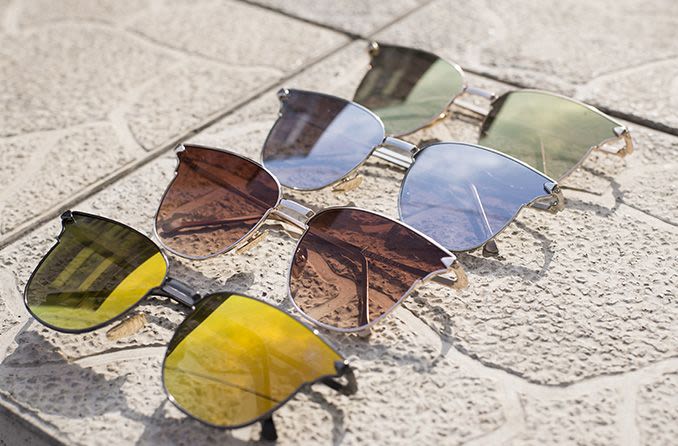Why different lens colors in sunglasses?

Benefits of various color lenses in sunglasses
Colored sunglasses lenses don’t exist only to make a fashion statement; they actually help filter light away from your eyes. But, depending on the lens color, they do so in different ways.
Some sunglasses tints enhance colors you see, making them appear more vivid. Other tint colors distort colors, reduce glare, block light and may even boost visual function. That said, not all colored lenses are right for all occasions.
The reality is, each colored lens provides different benefits. The right lens tint should ultimately enhance your depth perception and reduce eye fatigue without hindering your ability to see clearly.
UV protection matters more than lens color
First and foremost, the color of your sunglasses lenses is not an indicator of how much UV-blocking protection your sunglasses will provide. That’s because lenses that provide adequate protection are treated with a colorless UV-absorbing coating — hopefully, in addition to whatever colored tint you choose.
In other words, it’s not the color that matters when it comes to shielding your eyes from harmful ultraviolet rays; it’s what’s on the UV label that counts. And the label on any quality pair of sunglasses should read 100% UV protection, whatever color the lenses.
The color of your lenses does matter, however, when you are looking to filter high-energy visible light (HEV), or blue-violet light. There is a spectrum of blue light, and different tints are able to filter different wavelengths and amounts. Knowing your colored lens options and associated benefits is key.
SEE RELATED: Your guide to sport sunglass lens tints
Differences among color lenses in sunglasses
When choosing colored lenses, be sure to consider your lifestyle, such as daily work and recreational activities, and how you plan to use your sunglasses. Each color is specifically suited to enhance and improve vision in certain settings and activities.
At the same time, some colors can actually disrupt vision when worn in the wrong setting. So understanding the purpose and benefits of each color will help you make the right selection when it’s time to make your next purchase.
Green
A greenish colored lens helps provide contrast by filtering out some blue light. This also helps reduce glare and eye strain in brighter sunlight. This tint works well in sunglasses used to play golf or tennis and for everyday wear.
SEE RELATED: Famous golfers and their sunglasses
Gray
This neutral color reduces glare, especially when on the water, which is especially helpful for fishing sunglasses, and it’s a great color to shield bright light. Gray-tinted lenses work well on both cloudy and sunny days, providing anti-fatigue benefits, which make them great for all-purpose use, such as driving.
SEE RELATED: The best sunglasses for driving
Blue or purple
Blue- or purple-tinted sunglass lenses provide stunning and enhanced color perception. They also help you see contours around objects more clearly while offering protection from reflective surfaces, especially snow. Sunglasses with blue lenses also work well in foggy and misty weather. Plus, they look good on almost any skin tone.
SEE RELATED: What are the best sunglasses or goggles for snow skiing?
Red or rose
Red- and rose-colored sunglasses filter some blue light, so they may help improve driving visibility while also improving eye comfort. They may also help to increase your depth of field and enhance detail, which is why sunglasses with red- or rose-colored lenses are great to wear during many sports activities, such as skiing.
Yellow, orange or gold
Sunglasses with light-colored lenses such as yellow, orange and gold excel in moderate- to low-level light conditions. They provide excellent depth perception and also work well for both outdoor and indoor sports sunglasses. They also improve the visibility of objects, make surroundings appear brighter and filter blue light. However, yellow, orange or gold sunglass lenses may distort color.
Amber or brown
This glare-reducing tint helps make cloudy days a bit brighter. These performance sunglasses also include red hues that filter blue light while helping improve depth perception. So, think of wearing these during activities like golf or baseball, where you need to make out small objects at a distance. Amber lenses also comfort eyes in sunny conditions and heighten contrast against green landscapes and blue skies.
Before purchasing sunglasses with colored lenses, try to evaluate the different lens colors in lighting conditions similar to what you typically experience. Some sportier sunglasses frames even include interchangeable lenses so you can customize the tint for various activities and conditions.
Page published on Thursday, March 5, 2020
Page updated on Tuesday, June 27, 2023
Medically reviewed on Monday, June 19, 2023






